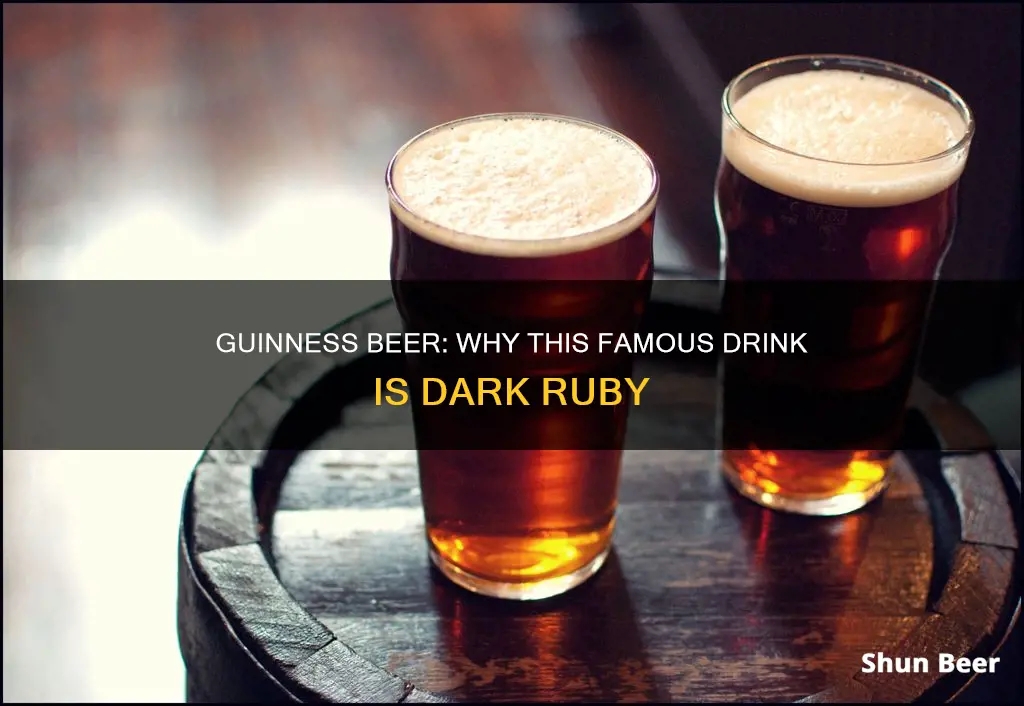
Guinness, the iconic Irish stout, is often perceived as black, but it is not. When held up to the light, the beer is revealed to be a deep ruby red colour. This distinctive hue is a result of the way the malted barley is roasted during the beer's preparation. The roasted barley also contributes to the beer's unique taste. Although Guinness is marketed as the black stuff, the company acknowledges that the drink is officially a very dark shade of ruby.
| Characteristics | Values |
|---|---|
| Colour | Dark ruby red |
| Ingredients | Water, barley, malted barley, roasted barley, hops, yeast |
| Calories | 210 in a standard pint |
What You'll Learn

The ruby red colour comes from roasted barley
The ruby red colour of Guinness beer comes from roasted barley. The barley is roasted in a similar way to coffee beans, which gives Guinness its distinctive colour. The beer is not actually black, but a deep, chocolate brown. However, when held up to the light, the stout is revealed to be ruby red in colour. This unique hue is a result of the way the malted barley is roasted during the beer's preparation.
The roasting process is an important step in the creation of Guinness beer. The barley is heated to high temperatures, causing it to turn brown and develop a rich, nutty flavour. This step not only contributes to the colour of the beer but also enhances its taste and aroma. The roasted barley is then combined with other key ingredients, including malted barley, hops, yeast, and water, to create the iconic brew.
The roasting process also has an impact on the nutritional value of the barley. Roasting reduces the sugar content of the barley while increasing its fibre content. Additionally, roasting can enhance the bioavailability of certain minerals, such as iron and zinc, making them more easily absorbed by the body.
Guinness has a long history dating back to the 18th century when Arthur Guinness established his brewery at St. James's Gate in Dublin, Ireland. Over the years, Guinness has become one of the most successful alcohol brands worldwide, available in over 120 countries. The unique ruby red colour of the beer has become synonymous with the brand, and it has played a crucial role in its marketing and popularity.
The ruby red colour of Guinness is so distinctive that it has even been referenced in marketing campaigns and advertisements. The beer is often referred to as "the black stuff" in marketing materials, but it is also officially recognised as a very dark shade of ruby. This unique colour has become an iconic part of the Guinness brand and has helped to set it apart from other beers on the market.
Vegan Alert: Guinness Beer's Surprising Ingredient
You may want to see also

It's not actually black, but dark ruby red
While Guinness beer is often perceived as black, it is not actually black but a very dark shade of ruby red. When you hold a pint of Guinness up to the light, you will see that this stout is, in fact, ruby red. This distinctive ruby red colour is a result of the way the ingredients, particularly the malted barley, are prepared and roasted during the beer's production. Some raw barley is roasted, similar to coffee beans, which gives Guinness its unique dark colour.
The perception of Guinness as a black drink is so widespread that it is often referred to as "the black stuff" in marketing campaigns and popular culture. This perception is understandable, as the beer appears black or, at best, a deep, deep chocolate brown when poured into a glass. However, when exposed to light, the ruby red hue becomes apparent, revealing the beer's true colour.
The roasting process of the barley plays a crucial role in developing the deep, dark shade of ruby red that characterises Guinness. During roasting, barley grains undergo a transformation, developing a deep, dark hue that is then transferred to the beer during brewing. This roasting technique is similar to that used for coffee beans and contributes to the unique flavour and aroma of Guinness.
The ruby red colour of Guinness is not just a visual trait but also has symbolic value for the brand. The colour red is often associated with passion, intensity, and energy, which aligns with the drinking experience that Guinness offers. The depth of the ruby red shade also conveys a sense of richness and complexity, reflecting the full-bodied flavour and texture of the beer.
In summary, while Guinness is commonly perceived as a black beverage, its true colour is a dark shade of ruby red. This distinctive colour is a result of the careful preparation and roasting of the ingredients, particularly the malted barley. The ruby red hue, when exposed to light, adds a layer of intrigue to the drinking experience, enhancing the overall appeal of this iconic beer.
Guinness Beer and Caffeine: What's the Connection?
You may want to see also

The beer is nitrogenated, which gives it its creamy mouthfeel
Guinness beer is nitrogenated, which gives it its distinctive creamy mouthfeel. Nitrogenation is a process that involves infusing the beer with nitrogen gas, which has a transformative effect on the beer's texture and flavour. This technique was first introduced to Guinness by mathematician-turned-brewer Michael Ash in 1959, marking a significant departure from the sharp and traditionally bitter taste of carbon dioxide-based beers.
Nitrogen bubbles are much smaller than carbon dioxide bubbles, resulting in a "creamier" and "smoother" consistency. This creaminess is particularly noticeable in the tight, white, creamy head of a freshly poured pint of Guinness. The smaller nitrogen bubbles also contribute to a more delicate taste, creating a sweeter and more mellow finish that has become synonymous with the Guinness brand.
The nitrogenation process involves adding pressurised nitrogen to the beer. In the case of canned Guinness, this is achieved through the use of a widget, a small, hollow, spherical piece of food-grade plastic with a tiny hole. During canning, liquid nitrogen is added to the beer, and as it evaporates, pressure builds up inside the can, forcing gas and liquid into the widget. When the can is opened, the pressurised nitrogen is released from the widget, creating the iconic surge of bubbles and mixing with the beer to form the creamy head.
The widget was invented by Guinness in 1969 to address the challenge of bringing their nitrogenated stout to consumers outside of pubs. However, it wasn't until 1989 that they released their first-generation widget, a flattened disc that sat at the bottom of the can. While it worked well with cold beer, it caused overflow when the beer was warm. In 1997, Guinness introduced the second iteration, a floating spherical widget resembling a ping pong ball, which effectively solved the overflow issue.
The nitrogenation process is not only crucial to the unique mouthfeel of Guinness but also ensures that the beer can be packaged and distributed without losing its distinctive characteristics. The widget, in particular, has played a pivotal role in delivering the perfect draught experience in a can, contributing to the enduring popularity of Guinness worldwide.
Guinness Beer: German or Irish?
You may want to see also

The two-part pour is a historical ritual
The two-part pour ritual holds a significant meaning for Guinness drinkers and is seen as a way to honour the rich history of the beverage. It is believed that the ritual originated from the early days of Guinness brewing, when the beer was still cask-conditioned. The two-part pour was necessary to manage the excessive frothiness of the beer, as it had not yet adopted the modern nitrogen and carbon dioxide gas mixture. By pouring the beer in two stages, the bartender could control the amount of froth and create a perfect pint.
Over time, the two-part pour became an integral part of the Guinness drinking experience. It is said that Arthur Guinness himself preferred his beer to be served using this method, and the tradition has been passed down through generations of drinkers and bartenders. The ritual is often accompanied by a moment of silence or reflection, as drinkers appreciate the complex flavours and history of the beer.
In addition to its historical significance, the two-part pour also has a practical purpose. By allowing the beer to settle between pours, drinkers can ensure that the famous creamy head of the Guinness is achieved. This creamy head is a result of the nitrogen and carbon dioxide gas mix, which creates a smooth and velvety texture that is beloved by Guinness enthusiasts worldwide. The two-part pour also helps to release the distinct aroma of the beer, enhancing the overall drinking experience.
The two-part pour ritual has become an iconic symbol of Guinness and is recognised worldwide. It is often seen as a sign of a skilled and knowledgeable bartender, and many establishments take pride in their ability to execute the perfect two-part pour. The ritual has even inspired innovations such as the "surger" unit, which was introduced in the early 2000s to replicate the two-part pour experience at home.
Guinness Beer and Coffee: What's the Connection?
You may want to see also

It's enormously popular in Africa
Guinness beer is a dark ruby red colour, although it is often perceived as black. The beer is the result of a combination of roasted barley, malted barley, hops, yeast and water. It is enormously popular in Africa, with Nigeria, Cameroon and Ghana being some of the top-consuming countries. In fact, Nigeria surpassed Ireland as the second-largest Guinness market in 2010.
The popularity of Guinness in Africa can be attributed to a variety of factors, including colonial export and locally driven marketing campaigns. The beer was first exported to Africa in 1827, following the routes established by the British Empire. Lagos, Nigeria, became the first location of a Guinness brewery outside the UK and Ireland in 1962, two years after the country gained independence. The establishment of this brewery was a significant factor in the drink's popularity, with another brewery soon following in Cameroon in 1970. Today, there are 13 breweries in Africa that produce Guinness.
The brand's marketing campaigns have also played a pivotal role in its success. One of the most notable campaigns featured the character Michael Power, an African "James Bond". This campaign played into cultural ideals of a strong African male and was a huge success, running from 1999 to 2006. Guinness has continued to build on this theme, associating their stout with the concepts of "greatness" and being "more than" in their advertising across the continent.
The taste of Guinness has also been tailored to suit the African market. The Foreign Extra Stout, which makes up the vast majority of Guinness consumed in Africa, is brewed with maize or sorghum, resulting in a more bitter taste than the standard draught. This variation, with its higher alcohol content, was originally designed to survive long sea journeys to foreign ports. The flavour extract, brewed in Ireland, ensures that the unique taste of Guinness is consistent worldwide.
Today, Africa is a critical market for Guinness, with about 40% of worldwide total volume being brewed and sold on the continent. The brand's parent company, Diageo, recognises the significance of this market, with Africa being the biggest source of beer sales for the multinational corporation.
Guinness Beer Mixology: Creative Concoctions for a Unique Taste
You may want to see also
Frequently asked questions
Guinness beer is often perceived as black, but it is actually a very dark shade of ruby red.
The ruby red colour is a result of the way the barley is roasted during the beer's preparation.
Hold a pint of Guinness beer up to the light and you will see that it is ruby red.







